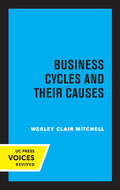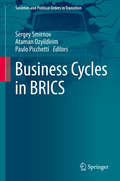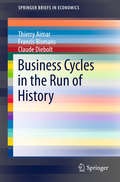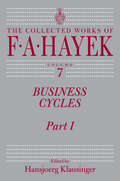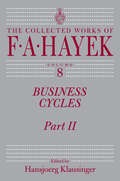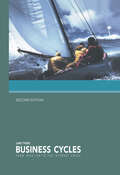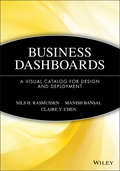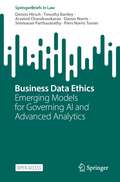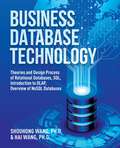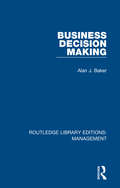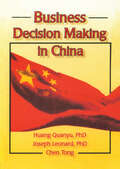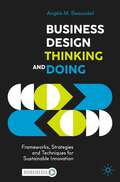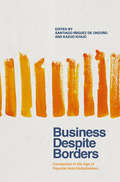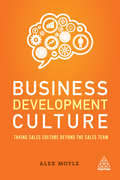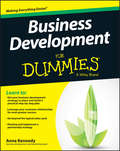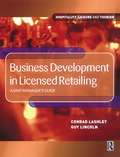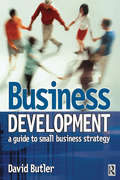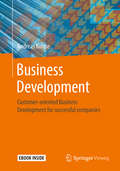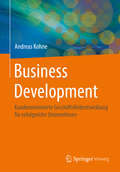- Table View
- List View
Business Cycles and Their Causes
by Wesley Clair MitchellThis title is part of UC Press's Voices Revived program, which commemorates University of California Press’s mission to seek out and cultivate the brightest minds and give them voice, reach, and impact. Drawing on a backlist dating to 1893, Voices Revived makes high-quality, peer-reviewed scholarship accessible once again using print-on-demand technology. This title was originally published in 1941.
Business Cycles in BRICS (Societies and Political Orders in Transition)
by Sergey Smirnov Ataman Ozyildirim Paulo PicchettiThis volume focuses on the analysis and measurement of business cycles in Brazil, Russia, India, China and South Africa (BRICS). Divided into five parts, it begins with an overview of the main concepts and problems involved in monitoring and forecasting business cycles. Then it highlights the role of BRICS in the global economy and explores the interrelatedness of business cycles within BRICS. In turn, part two provides studies on the historical development of business cycles in the individual BRICS countries and describes the driving forces behind those cycles. Parts three and four present national business tendency surveys and composite cyclical indices for real-time monitoring and forecasting of various BRICS economies, while the final part discusses how the lessons learned in the BRICS countries can be used for the analysis of business cycles and their socio-political consequences in other emerging countries.
Business Cycles in Economic Thought: A history (Routledge Studies in the History of Economics)
by Monika Poettinger Alain Alcouffe Bertram SchefoldBusiness Cycles in Economic Thought underlines how, over the time span of two centuries, economic thought interacted with cycles in a continuous renewal of theories and rethinking of policies, whilst economic actions embedded themselves into past economic thought. This book argues that studying crises and periods of growth in different European countries will help to understand how different national, political and cultural traditions influenced the complex interaction of economic cycles and economic theorizing. The editors of this great volume bring together expert contributors consisting of economists, historians of economic thought and historians of economics, to analyse crises and theories of the nineteenth and the twentieth century. This is alongside a comprehensive outlook on the most relevant advances of economic theory in France, Germany and Italy, as well as coverage of non-European countries, such as the United States. Several of the highly prestigious Villa Vigoni Trilateral Conferences formed the background for the discussions in this book. This volume is of great interest to students and academics who study history of economic thought, political economy and macroeconomics.
Business Cycles in the Run of History (SpringerBriefs in Economics)
by Thierry Aimar Francis Bismans Claude DieboltThis book analyzes the development of economic cycles in the run of history. The focus is on the development of cycle theory, with maximum emphasis upon ideas. Chapter 1 delivers an overview of the debate about cycles before the 1970s. Chapter 2 completes this survey by presenting the main empirical investigations since that time. Finally, Chapters 3 and 4 illustrate the discourse, by presenting, in the tradition of Burns and Mitchell, original case studies on France, South Africa, and Germany.
Business Cycles, Part I: Part I (The Collected Works of F. A. Hayek)
by F. A. Hayek“The two Business Cycles volumes bring together” the Nobel Laureate economist’s “most substantial contributions to technical economics” (Roger W. Garrison, Auburn University).In the years following its publication, F. A. Hayek’s pioneering work on business cycles was regarded as an important challenge to what was later known as Keynesian macroeconomics. Today, as debates rage on over the monetary origins of the current economic and financial crisis, economists are once again paying heed to Hayek’s thoughts on the repercussions of excessive central bank interventions.The latest editions in the University of Chicago Press’s ongoing series The Collected Works of F. A. Hayek, these volumes bring together Hayek’s work on what causes periods of boom and bust in the economy. Moving away from the classical emphasis on equilibrium, Hayek demonstrates that business cycles are generated by the adaptation of the structure of production to changes in relative demand. Thus, when central banks artificially lower interest rates, the result is a misallocation of capital and the creation of asset bubbles and additional instability. Business Cycles, Part I contains Hayek’s two major monographs on the topic: Monetary Theory and the Trade Cycle and Prices and Production. Reproducing the text of the original 1933 translation of the former, this edition also draws on the original German, as well as more recent translations. For Prices and Production, a variorum edition is presented, incorporating the 1931 first edition and its 1935 revision. Business Cycles, Part II assembles a series of Hayek’s shorter papers on the topic.The two volumes of Business Cycles also include extensive introductions by Hansjoerg Klausinger, providing background on the evolution of Hayek’s thought.
Business Cycles, Part II: Business Cycles, Part II (The Collected Works of F. A. Hayek)
by F. A. HayekIn the years following its publication, F. A. Hayek’s pioneering work on business cycles was regarded as an important challenge to what was later known as Keynesian macroeconomics. Today, as debates rage on over the monetary origins of the current economic and financial crisis, economists are once again paying heed to Hayek’s thoughts on the repercussions of excessive central bank interventions. The latest editions in the University of Chicago Press’s ongoing series The Collected Works of F. A. Hayek, these volumes bring together Hayek’s work on what causes periods of boom and bust in the economy. Moving away from the classical emphasis on equilibrium, Hayek demonstrates that business cycles are generated by the adaptation of the structure of production to changes in relative demand. Thus, when central banks artificially lower interest rates, the result is a misallocation of capital and the creation of asset bubbles and additional instability. Business Cycles, Part I contains Hayek’s two major monographs on the topic: Monetary Theory and the Trade Cycle and Prices and Production. Reproducing the text of the original 1933 translation of the former, this edition also draws on the original German, as well as more recent translations. For Prices and Production, a variorum edition is presented, incorporating the 1931 first edition and its 1935 revision. Business Cycles, Part II assembles a series of Hayek’s shorter papers on the topic, ranging from the 1920s to 1981. In addition to bringing together Hayek’s work on the evolution of business cycles, the two volumes of Business Cycles also include extensive introductions by Hansjoerg Klausinger, placing the writings in intellectual context—including their reception and the theoretical debates to which they contributed—and providing background on the evolution of Hayek’s thought.
Business Cycles: History, Theory And Investment Reality
by Lars TvedeWhy do we experience business cycles? What creates them? Is it mass psychology, or phenomena in the management of business? Are the banks to blame or should we be looking to the unions and the politicians? Lars Tvede's story moves back in time to the Scottish gambler and financial genius, John Law, and then on to the distracted Adam Smith, the stockbroker Ricardo, the investment banker Thornton, the extrovert Schumpeter, the speculator Jay Gould and many others. The computer jugglers of the modern day, with giant networks of equations, try to solve the same questions that have attracted the attention of classical economists throughout the centuries. Throughout this volume, business cycle theories are used to explain actual events. Theoretical thinking has reflected the economist's own experiences of hyper-inflations, depressions, speculation orgies and liquidity squeezes. The reader can follow the narrative to discover how economists often thought that problems had been solved until new data changed the economic picture once again.
Business Cycles: Part I (The Collected Works of F.A. Hayek #7)
by F.A. HayekIn the years following its publication, F. A. Hayek's pioneering work on business cycles was regarded as an important challenge to what was later known as Keynesian macroeconomics. Today, as debates rage on over the monetary origins of the current economic and financial crisis, economists are once again paying heed to Hayek's thoughts on the repercussions of excessive central bank interventions. The latest editions in Routledge's ongoing series The Collected Works of F. A. Hayek, these volumes bring together Hayek's work on what causes periods of boom and bust in the economy. Moving away from the classical emphasis on equilibrium, Hayek demonstrates that business cycles are generated by the adaptation of the structure of production to changes in relative demand. Thus, when central banks artificially lower interest rates, the result is a misallocation of capital and the creation of asset bubbles and additional instability. Business Cycles: Part I contains Hayek's two major monographs on the topic: Monetary Theory and the Trade Cycle and Prices and Production. Reproducing the text of the original 1933 translation of the former, this edition also draws on the original German, as well as more recent translations. For Prices and Production, a variorum edition is presented, incorporating the 1931 first edition and its 1935 revision. Business Cycles: Part II assembles a series of Hayek's shorter papers on the topic, ranging from the 1920s to 1981. In addition to bringing together Hayek's work on the evolution of business cycles, the two volumes of Business Cycles also include extensive introductions by Hansjoerg Klausinger, placing the writings in intellectual context, including their reception and the theoretical debates to which they contributed, and providing background on the evolution of Hayek's thought.
Business Cycles: Part II (The Collected Works of F.A. Hayek #7)
by F.A. HayekIn the years following its publication, F. A. Hayek's pioneering work on business cycles was regarded as an important challenge to what was later known as Keynesian macroeconomics. Today, as debates rage on over the monetary origins of the current economic and financial crisis, economists are once again paying heed to Hayek's thoughts on the repercussions of excessive central bank interventions. The latest editions in Routledge's ongoing series The Collected Works of F. A. Hayek, these volumes bring together Hayek's work on what causes periods of boom and bust in the economy. Moving away from the classical emphasis on equilibrium, Hayek demonstrates that business cycles are generated by the adaptation of the structure of production to changes in relative demand. Thus, when central banks artificially lower interest rates, the result is a misallocation of capital and the creation of asset bubbles and additional instability. Business Cycles: Part I contains Hayek's two major monographs on the topic: Monetary Theory and the Trade Cycle and Prices and Production. Reproducing the text of the original 1933 translation of the former, this edition also draws on the original German, as well as more recent translations. For Prices and Production, a variorum edition is presented, incorporating the 1931 first edition and its 1935 revision. Business Cycles: Part II assembles a series of Hayek's shorter papers on the topic, ranging from the 1920s to 1981. In addition to bringing together Hayek's work on the evolution of business cycles, the two volumes of Business Cycles also include extensive introductions by Hansjoerg Klausinger, placing the writings in intellectual context, including their reception and the theoretical debates to which they contributed, and providing background on the evolution of Hayek's thought.
Business Dashboards
by Nils H. Rasmussen Claire Y. Chen Manish BansalFocusing on designing the right dashboards for use in an organization, this timely, full color book reveals how to successfully deploy dashboards by building the optimal software architecture and dashboard design. In addition, it describes the value of this popular technology to a business and how it can have a significant impact on performance improvement. A unique collection of more than 120 dashboard images are organized by category. One of the chapters provides a step-by-step description of the key performance indicator (KPIs) design process. One of the appendices contains more than 1,000 examples of KPIs to help design the content of dashboards. The book also describes all the steps in a dashboard implementation and offers related advice.Nils Rasmussen (West Hollywood, CA) is cofounder and Principal of Solver, Inc. Claire Y. Chen (Long Beach, CA) is a Senior Business Intelligence Architect at Solver, Inc. Manish Bansal (Irvine, CA) is Vice President of Sales at Solver, Inc.
Business Data Communications and Networking, 8th edition
by Jerry Fitzgerald Alan DennisThe goal of this book is to combine the fundemental concepts of data communications and networking with practical applications and is, in the first instance, a university textbook. Secondly, this books is intended for the professional who works in data communications and networking. The book contains many detailed descriptions of the technical aspects of communications. Technical Focus boxes highlight key issues provide additional details. Mini case studies at the end of each chapter provide the opportunity to apply these technical and management concepts.
Business Data Ethics: Emerging Models for Governing AI and Advanced Analytics (SpringerBriefs in Law)
by Piers Norris Turner Dennis Hirsch Timothy Bartley Aravind Chandrasekaran Davon Norris Srinivasan ParthasarathyThis open access book explains how leading business organizations attempt to achieve the responsible and ethical use of artificial intelligence (AI) and other advanced information technologies. These technologies can produce tremendous insights and benefits. But they can also invade privacy, perpetuate bias, and otherwise injure people and society. To use these technologies successfully, organizations need to implement them responsibly and ethically. The question is: how to do this? Data ethics management, and this book, provide some answers. The authors interviewed and surveyed data ethics managers at leading companies. They asked why these experts see data ethics as important and how they seek to achieve it. This book conveys the results of that research on a concise, accessible way. Much of the existing writing on data and AI ethics focuses either on macro-level ethical principles, or on micro-level product design and tooling. The interviews showed that companies need a third component: data ethics management. This third element consists of the management structures, processes, training and substantive benchmarks that companies use to operationalize their high-level ethical principles and to guide and hold accountable their developers. Data ethics management is the connective tissue makes ethical principles real. It is the focus of this book. This book should be of use to organizations that wish to improve their own data ethics management efforts, legislators and policymakers who hope to build on existing management practices, scholars who study beyond compliance business behavior, and members of the public who want to understand better the threats that AI poses and how to reduce them.
Business Database Technology (2nd Edition): Theories and Design Process of Relational Databases, SQL, Introduction to OLAP, Overview of NoSQL Databases
by Wang Shouhong WangBusiness Database Technology provides essential knowledge of database technology for four-year college/university business students who study information technology and data resource management. Students will learn basic data structure tec
Business Decision Making (Routledge Library Editions: Management)
by Alan J. BakerOriginally published in 1981. Risk is a problem which all business decision makers have to cope with. The problem is not insurmountable, however, as there now exist well-established techniques for minimising risk and for calculating which of various available options is the optimal one to pursue. This book outlines and discusses these techniques and the theories behind them. Unlike many economic theories which only rarely have any practical applications, the techniques put forward in this book can be used by real businessmen to solve real business problems. The book concentrates on decision-making in two main areas: the allocation of a firm’s resources and the selection of new investments; and the techniques and theories discussed fall into three broad groups: linear programming, decision theory and capital market theory. Intended as an advanced undergraduate textbook for students taking business economics or managerial economics courses, this valuable book will interest specialists and students involved in management studies, microeconomics, strategic planning, operational research, accounting and MBA programmes.
Business Decision Making in China
by Huang Quanyu Chen Tong Joseph W LeonardKnowledgeable decision making not only saves you time, money, and effort, but also leads you to extra opportunities. Business Decision Making in China improves your business acumen by showing you who (in itals) is involved in business decision making, how (in itals) decisions have been made, what (in itals) the characteristics and strategies of Chinese decision making are, and why (in itals) decision making has followed certain patterns in China. Practitioners, consultants, and government officials who are involved in business with China as well as academicians researching or teaching about business in East Asia will find this book to be an invaluable resource. Business Decision Making in China introduces you to such subjects as Chinese organizational structures and relationships, tactics of decision making, and traditional Chinese culture. Other vital topics you learn about include: the pros and cons of joint venture enterprises in China the climate for foreign banks operating in China the importance of saving face the concept of “the golden mean” the unity of opposites (Yin-Yang) the 4 realms of Chinese managers’daily affairs modes of thinking (universality versus individuality, thinking in images, understanding abstract thoughts) the parallels between the 5 elements (metal, wood, water, fire, earth) and the 4 P’s (product, price, promotion, place)As a guidebook for Chinese business, Business Decision Making in China addresses the broad and integrative discipline of decision making and helps Western business people (who have an entirely different set of patterns, styles, processes, philosophical thoughts, and tactics of decision making) to adapt to their Chinese business partners’or opponents’decision making. Since this book explains the profound process of Chinese decision making in uncomplicated terms and practical business experiences, readers will be able to apply their new knowledge to their long-range strategic planning, to skillfully solving their daily problems or questions, and to wisely avoiding losses from a multitude of potential pitfalls.
Business Design Thinking and Doing: Frameworks, Strategies and Techniques for Sustainable Innovation
by Angèle M. BeausoleilThis textbook aims to guide, instruct and inspire the next generation of innovation designers, managers and leaders. Building upon an evidence-based innovation development process, it introduces, explains and provides visual models and case examples of what Business Design is, how it is applied across sectors and organizations, and its impact on decision-making and value creation.Students will read and analyze design-led innovation business cases from across the globe, discover multi-disciplinary strategies (from marketing to anthropology) and practice applying a designer’s toolkit to find, frame, and solve business problems in contemporary ways. Throughout the book, students will break down the process of innovation and move from initiation to implementation, engage in iterative feedback loops, and develop concrete plans for personal and professional collaboration and workplace application.For MBA and senior undergraduate students, this book offers a step-by-step and comprehensive reference guide to creative problem framing and solving – inside and beyond the classroom. It integrates marketing principles and management frameworks, with anthropological and design methods reflecting the diverse and in-demand skills vital to tomorrow’s workforce.For instructors, this book offers a way to confidently engage learners in the realm of design practices and strategies relevant to business decision-making. The pedagogical framework, along with a comprehensive suite of techniques and templates, offers both novice and experienced teachers a step-by-step reference guide that facilitates skills development in creative problem framing and solving.
Business Despite Borders: Companies In The Age Of Populist Anti-globalization
by Santiago Iñiguez de Onzoño Kazuo IchijoGlobalization has been a key force in the development of business in recent decades. But with nationalism on the rise in Europe, the United States and elsewhere, the future of global trade and international business has been thrown into doubt. In this new and challenging context, innovative companies have the opportunity not only to find new ways to operate across borders, but also to help forge a new system of relations between people of different nationalities and cultures. This book features a collection of case studies that illustrate how companies from different corners of the globe are succeeding in reaching out to distant customers, stakeholders and partners. It features inspiring examples of leaders who are actively developing imaginative ways to connect across continents. It is a vital reference tool for companies that plan to continue operating globally or to expand their international presence. A clarion call for the renewed relevance and importance of globalized business, this book suggests a future where companies can contribute positively to achieving sustainable growth and a fairer distribution of wealth across the globe.
Business Development Culture: Taking Sales Culture Beyond the Sales Team
by Alex MoyleBusiness Development Culture defines how to facilitate a sales-oriented perspective throughout a company culture, enabling it to sell more on an ongoing and consistent basis. Highly practical in its approach, this book empowers readers to break away from the frustrations of missed opportunities and lost leads, and to escape the repetitive 'feast and famine' sales patterns. Providing direct guidance on the implementation of an immersive business development culture, this book will ensure that the wider objective of generating business profit is embraced by the entire organization, not just the sales team. Easily tailored to maximize current processes, Business Development Culture features numerous tools and market-tested insights to support leaders in adapting their approach at both team and strategy levels. This invaluable guidance to an ever-widening issue is driven through the author's extensive experience as a trainer, and a series of impacting interviews from across the industry. Insightful, practical and directly relevant, this book is an essential read to achieve stable, consistent growth, and ultimately, long-term profits.
Business Development For Dummies
by Anna KennedyGrowing a small business requires more than just sales Business Development For Dummies helps maximise the growth of small- or medium-sized businesses, with a step-by-step model for business development designed specifically for B2B or B2C service firms. By mapping business development to customer life cycle, this book helps owners and managers ensure a focus on growth through effective customer nurturing and management. It's not just sales! In-depth coverage also includes strategy, marketing, client management, and partnerships/alliances, helping you develop robust business practices that can be used every day. You'll learn how to structure, organise, and execute an effective development plan, with step-by-step expert guidance. Realising that you can't just "hire a sales guy" and expect immediate results is one of the toughest lessons small business CEOs have to learn. Developing a business is about more than just gaining customers – it's about integrating every facet of your business in an overarching strategy that continually works toward growth. Business Development For Dummies provides a model, and teaches you what you need to know to make it work for your business. Learn the core concepts of business development, and how it differs from sales Build a practical, step-by-step business development strategy Incorporate marketing, sales, and customer management in general planning Develop and implement a growth-enhancing partnership strategy Recognising that business development is much more than just sales is the first important step to sustained growth. Development should be daily – not just when business starts to tail off, or you fall into a cycle of growth and regression. Plan for growth, and make it stick – Business Development For Dummies shows you how.
Business Development and Economic Governance in Southeastern Europe: 13th International Conference on the Economies of the Balkan and Eastern European Countries (EBEEC), Pafos, Cyprus, 2021 (Springer Proceedings in Business and Economics)
by Anastasios Karasavvoglou Persefoni Polychronidou Pantelis Sklias Nikolaos Apostolopoulos Victoria PistikouThis book addresses contemporary and modern topics around business growth and economic development in Southeastern Europe. It covers a wide range of business issues focusing on the adoption of new technologies, finance of SMEs, place marketing, value co-creation, contribution to economic growth, and internationalization. Moverover, it sheds new light on the micro- and macroeconomic developments and monetary policy issues in the Eastern European and Balkan countries. This book is a useful tool for scholars in economics and finance interested in the further economic development of the Balkans and Eastern European countries as well as to professionals in the business, financial and insurance sectors.
Business Development for the Biotechnology and Pharmaceutical Industry
by Martin AustinBusiness Development in the biotechnology and pharmaceutical industries accounts for over $5 billion in licensing deal value per year and much more than that in the value of mergers and acquisitions. Transactions range from licences to patented academic research, to product developments as licences, joint ventures and acquisition of intellectual property rights, and on to collaborations in development and marketing, locally or across the globe. Asset sales, mergers and corporate takeovers are also a part of the business development remit. The scope of the job can be immense, spanning the life-cycle of products from the earliest levels of research to the disposal of residual marketing rights, involving legal regulatory manufacturing, clinical development, sales and marketing and financial aspects. The knowledge and skills required of practitioners must be similarly broad, yet the availability of information for developing a career in business development is sparse. Martin Austin's highly practical guide spans the complete process and is based on his 30 years of experience in the industry and the well-established training programme that he has developed and delivers to pharmaceutical executives from across the world.
Business Development in Licensed Retailing
by Conrad Lashley Guy Lincoln'Business Development in Licensed Retailing: a unit manager's guide' details the indispensable skills and techniques needed to manage units within licensed retail organisations in a flexible and entrepreneurial manner. This book: · Forms the basis of a complete course for a unit manager's development.· Provides an overview of the range of skills needed for effective unit management. · Supports the development of techniques with examples from existing best practice and case examples from companies such as JD Wetherspoon's, TGI Fridays and McDonald's amongst others.Business Development in Licensed Retailing considers the functional management techniques required at unit management level, covering recruitment, human resource management, operations, service quality and customer relations, financial measurement and analysis, promotions and strategic planning. The analysis systematically provides all the practical know-how you need to produce of a comprehensive business plan for your unit. Ending with a comprehensive case study that demonstrates all the aspects of business development working in a real-life scenario, the text is ideally suited for lecturers and management development personnel to use as a learning resource through which readers can apply the principles and techniques outlined.
Business Development: A Guide To Small Business Strategy
by David Butler'Business Development' provides a readable and practical book for the growth and development of businesses. This is primarily a textbook for the NVQ4 Business Development qualification, the Institute of Management Certificate in Owner Management courses, and HND Small business modules, but the text is also an invaluable practical guide to owner-managers of small businesses. All businesses pass through several stages of growth and it occurs for a number of reasons, such as change in the commercial market, increased customer demand for services or product, higher numbers of customers. Business Development shows how to make the most of this growth and also how to deal with the different types of problems that are encountered along the way. The book is structured to follow a logical sequence of questions that makes it readily accessible: Where are we now? Where do we want to go? What resources are needed to get there? What sales and marketing policies do we need to develop? It examines the personnel and staffing implications, the efficiency of the current financial management process, and the owner's own abilities to make it all happen. Most important of all it makes the owner-manager takes a long, hard look at the business and where it is really going.
Business Development: Customer-oriented Business Development for successful companies
by Andreas KohneThe book provides a compact overview of the increasingly important topic of Business Development (BD). The author not only describes the role of the Business Development Manager and its tasks, but also shows how Business Development can be integrated organizationally into a company. In addition, a prototypical Business Development Process is presented in concrete terms and explained using a case study. The book shows why enterprises fail, deals with new creative techniques such as Hackthons and dedicates itself more comprehensively than so far to the topic of communication in the course of changes.The book helps all, which want to introduce and/or optimize Business Development in the enterprise as responsible ones or work in the future in this range.
Business Development: Kundenorientierte Geschäftsfeldentwicklung für erfolgreiche Unternehmen
by Andreas KohneDas Buch gibt einen kompakten #65533;berblick #65533;ber das immer wichtiger werdende Thema Business Development (BD). Dazu beschreibt der Autor nicht nur die Rolle des Business Development Managers mit ihren Aufgaben, sondern er zeigt auch, wie Business Development organisatorisch in eine Firma integriert werden kann. Dar#65533;ber hinaus wird ein prototypischer Business Development-Prozess konkret vorgestellt und anhand einer Fallstudie erl#65533;utert. Das Fachbuch hilft allen, die als Verantwortliche Business Development im Unternehmen einf#65533;hren bzw. optimieren wollen oder zuk#65533;nftig in diesem Bereich arbeiten.
